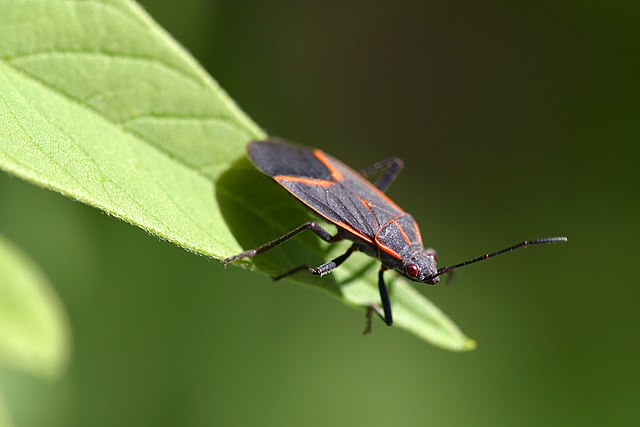This is the second part of a series on spring tree insects. This article examines black vine weevil, and box elder bug.
Introduction
In spring, deciduous trees break dormancy, and resume the growing process. During this period, many insects become active, emerging from their overwintering sites to plague their hosts. The following describes some of the insects that may be commonly observed in spring, and how they can impact susceptible trees.
Black Vine Weevil (Otiorhynchus sulcatus)
Black vine weevil, also referred to as vine weevil or taxus weevil, is a serious pest of ornamental plantings. The insect is most destructive in its larval stage, when it feeds on the roots of host plants.
Hosts
Black vine weevil has been reported to infest more than one hundred species of plants. The insect prefers bergenis, euonymus, Japanese holly, rhododendron, and yew. In addition to these hosts, the larvae feed on the roots of hemlock, as well as various weeds, such as cocklebur, Joe-pye weed, morning glory, ragweed, and thistle. Other plants prone to infestation include asters, azalea, begonia, cyclamens, forsythia, fuchsia, hemlock, impatiens, primrose, and sedum. The insect commonly infests blueberry, blackberry, cranberry, and strawberry plants.
Symptoms of Infestation
The larvae feed on the roots of host plants. They initially feed on small tender roots, before progressing to the bark of large roots, or the stem. This generally results in the destruction of the plant’s root system. Infested plants in landscape settings often succumb to the widespread root destruction. The adults feed on the outer edges of the plant’s leaves, causing the leaves to develop notched margins. Evergreen plants, such as rhododendron, euonymus, and bergenis are particularly susceptible to this type of injury. Marginal notching of the foliage seldom impacts plant health. Significant notching of the leaves can reduce the ornamental value of the host.
Treatment
- Various insecticides are registered for use on black vine weevil. Applications should be performed on plant foliage from mid-May to early June, with two subsequent applications made at fourteen day intervals. For the best results, spray plant foliage in the early evening, when the adults become active, and resume their feeding activities.
- Soil insecticides are effective at controlling the larvae. Insecticides can be administered from July to October.
- For plants that are grown in gardens or containers, beneficial nematodes can assist in managing the larvae. To ensure success, release nematodes into gardens and containers in early June. Apply water to the soil as directed by the product label.
- Sticky barriers may be used to deter the adults from ascending the trunks of host plants. Avoid placing the sticky material directly on the bark.
- The adults can be manually removed from the foliage at night. Gently shake the plants to dislodge the insects. If desired, the adults may be submerged in soapy water thereafter.
- Remove dead or infested foliage to limit overwintering sites. Discard infested plant material, including the soil around the root system.
- Eradicate weeds from lawns and gardens to remove potential food sources.
- Black vine weevil has several natural predators that help to limit its populations. These include bluebirds, warblers, and wrens.
Box Elder Bug (Boisea trivittata)
Box elder bug is a North American species of true bug in the family Rhopalidae. The insect is native to the western United States, where it frequently infests maple and boxelder trees. From spring to fall, box elder bugs congregate on plants, sometimes in large quantities. As temperatures drop in autumn, box elder bugs will invade households and other buildings, where they can become a nuisance.
Hosts
Box elder bug primarily infests maple and seed-bearing boxelder trees. It also occasionally infests and feeds on the fruit of plum and apple trees.
Symptoms of Infestation
When populations are dense, the nymphs can be observed crawling on the ground, scouring gardens, and feeding on the foliage of host trees. Box elder bugs tend to aggregate on the southern and western exposures of tall structures and isolated buildings. As temperatures plummet in fall, the adults may penetrate into the interior of households, and other buildings. If disturbed, box elder bugs will expel a pungent compound, which can leave a reddish-orange stain on walls, curtains, and furniture. The insect’s mouthparts can puncture skin, causing a slight irritation, with a red spot arising in the center of the affected area.
Treatment
- Repair holes in windows and doors to prevent entry to the adults.
- When the insect is present within a building, avoid fumigating. The husks of the dead insects will attract dermestid beetles, which can be destructive pests.
- Use a broom or a vacuum to remove expired box elder bugs from households. Dispose of them in a trash bag or vacuum bag.
- Residual insecticides can be employed in spring and fall to deter the adults from landing on buildings.
- A solution composed of ½ cup of dish soap and 1 gallon of water can be used to eliminate box elder bugs on plants, and the exterior of buildings.
Photo courtesy of Tom Murphy VII CC-by-3.0


